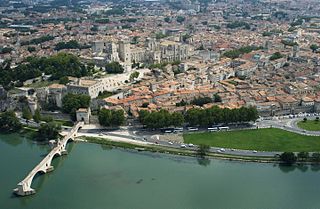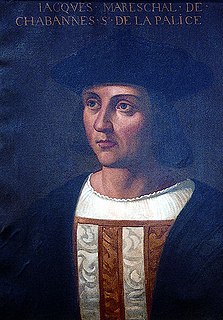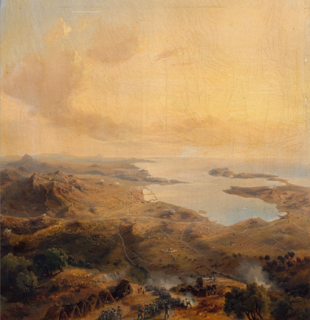
Pope Gregory XI was head of the Catholic Church from 30 December 1370 to his death in 1378. He was the seventh and last Avignon pope and the most recent French pope. In 1377, Gregory XI returned the Papal court to Rome, ending nearly 70 years of papal residency in Avignon, France. His death shortly after was followed by the Western Schism involving two Avignon-based antipopes.

Avignon is the prefecture of the Vaucluse department in the Provence-Alpes-Côte d'Azur region of Southeastern France. Located on the left bank of the river Rhône, the commune had a population of 93,671 as of the census results of 2017, with about 16,000 living in the ancient town centre enclosed by its medieval ramparts.

The Avignon Papacy, also known as the Babylonian Captivity, was the period from 1309 to 1376 during which seven successive popes resided in Avignon rather than in Rome. The situation arose from the conflict between the papacy and the French crown, culminating in the death of Pope Boniface VIII after his arrest and maltreatment by Philip IV of France. Following the further death of Pope Benedict XI, Philip forced a deadlocked conclave to elect the French Clement V as pope in 1305. Clement refused to move to Rome, and in 1309 he moved his court to the papal enclave at Avignon, where it remained for the next 67 years. This absence from Rome is sometimes referred to as the "Babylonian captivity of the Papacy".

Jacques de La Palice was a French nobleman and military officer. His full name and titles were Jacques II de Chabannes, Lord of La Palice, of Pacy, of Chauverothe, of Bort-le-Comte and of Héron. In 1511, he received the title of Grand Master of France.

The Palais des Papes is a historical palace located in Avignon, Southern France. It is one of the largest and most important medieval Gothic buildings in Europe. Once a fortress and palace, the papal residence was the seat of Western Christianity during the 14th century. Six papal conclaves were held in the Palais, leading to the elections of Benedict XII in 1334, Clement VI in 1342, Innocent VI in 1352, Urban V in 1362, Gregory XI in 1370 and Benedict XIII in 1394.

The Pont Saint-Bénézet, also known as the Pont d'Avignon, is a famous medieval bridge in the town of Avignon, in southern France.

Charles of Blois-Châtillon "the Saint", was the legalist Duke of Brittany from 1341 to his death via his marriage to Joan of Penthiève, holding the title against the claims of John of Montfort. The cause of his possible canonization was the subject of a good deal political maneuvering on the part of his cousin, Charles V of France who endorsed it, and his rival, Montfort, who opposed it. The cause fell dormant after Pope Gregory XI left Avignon in 1376, but was revived in 1894. Charles of Blois was beatified in 1904.

Peter I of Bourbon was the second Duke of Bourbon, from 1342 to his death.

Pedro Martínez de Luna y Pérez de Gotor, known as el Papa Luna in Spanish and Pope Luna in English, was an Aragonese nobleman, who as Benedict XIII, is considered an antipope by the Catholic Church.

The Siege of Toulon was a military operation by Republican forces against a Royalist rebellion in the southern French city of Toulon during the Federalist revolts.

Louis des Balbes de Berton de Crillon was a French soldier, called the man without fear and, by Henry IV the brave of the brave.

The Siege of Avignon, in which Frankish forces led by Charles Martel beat the Umayyad garrison of Avignon and destroyed the stronghold, was contested in 737.

Athlétic Club Arles-Avignon was a French association football club originally based in Arles. The club was founded in 1912 as a result of a merger and was formerly known as Athlétic Club Arles, but in 2010, moved to the nearby commune of Avignon and adopted its current name. Arles-Avignon last played in the Championnat de France Amateur, the fourth division in French football; it previously gained four promotions in five seasons to reach Ligue 1 in 2010.
Mummolus, was a Gallo-Roman patrician and prefect who served Guntram, King of Burgundy, as a general in the 6th century.
Bertran Folcon d'Avignon or Bertran Folco d'Avinhon was a Provençal nobleman and troubadour from Avignon. He was a faithful partisan of Raymond VI and Raymond VII of Toulouse in Provence, and participated in the wars against the Albigensian Crusade. He was inside the city during the siege of Beaucaire in 1216. In 1226 Raymond VII appointed him bailiff of Avignon.

Elzéar Auguste Cousin de Dommartin became a French general during the French Revolutionary Wars, fought in Italy under Napoleon Bonaparte, and commanded the artillery division of the Armée d'Orient during the French invasion of Egypt in 1798.

The following is a timeline of the history of the city of Avignon in southern France.

The Franco-Visigothic Wars were a series of wars between the Franks and the Visigoths, but it also involved the Burgundians, the Ostrogoths and the Romans. Most noteworthy war of the conflict would be the Second Franco-Visigothic War that included the famous Battle of Vouillé and resulted in Frankish annexation of most of Southern France.

The Siege of Avignon was the principle military action of the Albigensian Crusade of 1226. King Louis VIII of France besieged the town of Avignon, which lay within the Holy Roman Empire, from 10 June until 9 September, when it surrendered on terms.
















